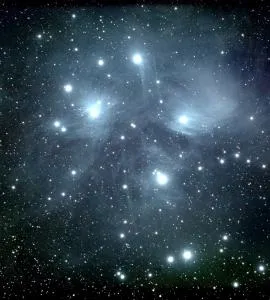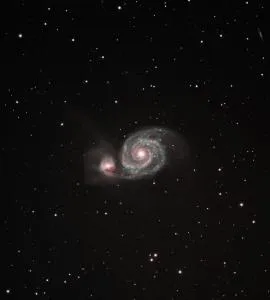IC 1396 Elephants Trunk Nebula from the Ozarks

IC 1396, known as the Elephant's Trunk Nebula, is a stunning region of ionized gas and interstellar dust in the constellation Cepheus. Captured from the Ozarks in Missouri by Richard Harris, this image showcases intricate structures and vibrant colors, highlighting the beauty of this cosmic formation.
The Elephant’s Trunk Nebula, an emission nebula in the constellation Cepheus, can be located by looking toward the Garnet Star (Mu Cephei), which is East from my location here in the Ozarks
One amazing fact that the nebula is over 20 light years long! So, approximately 14.85 billion Earths could fit into a distance of 20 light-years laid end-to-end. The nebula is giant huge!
The image above was captured from our observation decks at the observatory using RGB filters, along with narrowband filters and the Hubble Palette, which maps specific filters to gases (H-alpha, OIII, and SII).


The Elephant's Trunk Nebula, designated as IC 1396A, is a concentration of interstellar gas and dust within the larger emission nebula IC 1396. Located in the constellation Cepheus, this nebula is approximately 2,400 light-years away from Earth. The Elephant's Trunk Nebula gets its name due to its elongated shape, resembling the trunk of an elephant.
Key Characteristics:
1. Structure and Composition:
- Emission Nebula: The region is primarily composed of ionized hydrogen gas (H II region), which emits light as it recombines with electrons.
- Dark Nebula: The "trunk" itself is a dark nebula, containing dense clouds of gas and dust that block light from behind it.
- Star Formation: The nebula is an active star-forming region, with young stars and protostars embedded within its dense clouds.
2. Hubble Palette Imaging:
- The Hubble Palette is a popular technique in astrophotography, mapping specific wavelengths of light to colors:
- H-alpha (Hydrogen Alpha): Often mapped to green, this emission line is produced by ionized hydrogen.
- OIII (Doubly Ionized Oxygen): Usually mapped to blue, representing the emission from oxygen.
- SII (Singly Ionized Sulfur): Typically mapped to red, indicating the presence of sulfur.
- This method highlights the different elements present and brings out intricate details of the nebula's structure.
3. Astrophotography:
- Narrowband Filters: Used to isolate the light from specific gases, allowing for more detailed and contrasted images.
- Location and Equipment: Astrophotographers often capture images of IC 1396A using high-quality telescopes and cameras, with advanced setups even possible from urban areas using appropriate filters to reduce light pollution.
4. Astronomical Significance:
- Cepheus Constellation: IC 1396A is located near the Garnet Star (Mu Cephei), a red supergiant known for its deep red color.
- Stellar Winds and Radiation: The region is shaped by the intense radiation and stellar winds from nearby massive stars, which erode and illuminate the surrounding gas and dust.
Observing IC 1396A:
- Visual Observation: While challenging to see in small telescopes due to its faintness, larger amateur telescopes can reveal some of its structure.
- Imaging: Astrophotographers can capture stunning images using long exposures and specialized equipment, revealing the nebula's beauty in detail.
Educational and Scientific Value:
- The Elephant's Trunk Nebula is an excellent target for studying star formation and the effects of stellar radiation on interstellar material.
- It serves as a beautiful example of the dynamic processes occurring within our galaxy, contributing to our understanding of cosmic evolution.
The Elephant's Trunk Nebula remains a favorite subject among astronomers and astrophotographers, illustrating the breathtaking complexity and beauty of our universe.

Elephant's Trunk Nebula IC 1396 astrophoto acquisition details
Date: July 14, 2024
Direction of Observation: East 52.5 degrees, Alt = +30.6 degrees
Telescope: Takahashi FSQ-106EDEX4 at 530mm, F5
Mount: ZWO AM5
Camera: ZWO 2600MM (monochrome), Temp= -20, Gain= 300 / ZWO RGBL + HO filters
Guide Scope: Williams Optics 50mm
Guider: ZWO ASI 120 mini
Controller: ZWO ASI Air
Acquisition:
Hydrogen Alpha: 20 frames at 300s each = 1.6 hours
Oxygen III: 20 frames at 300s each = 1.6 hours
Red: 5 frames at 300s each = 35 minutes
Blue: 5 frames at 300s each = 35 minutes
Green: 5 frames at 300s each = 35 minutes
Lum: 10 frames at 300s each = .8 hours
Total acquisition time = 6 hours
Darks/Flats/Bias: (None)
Processing: Pixinsight, Photoshop over 2 days
Location: Missouri
Bortle Class Sky: 4
Ozarks Explanation of the Elephant's Trunk Nebula
Well, lemme tell ya 'bout the Elephant's Trunk Nebula in a way that'd make ol' Uncle Jeb proud! So up in the night sky, in this fancy constellation called Cepheus, there's this big ol' cloud of space dust and gas. It's all twisty and turny, lookin' like an elephant's trunk, hence the name.
Now, if ya squint real hard towards the Garnet Star, which is kinda like the brightest Christmas light on the porch, you'll find this nebula. It's like one of them smoke rings Grandpa used to blow, only it's filled with stars bein' born, kinda like a cosmic nursery.
Astrophotographers, those city folks with all their fancy gear, use these narrowband filters – think of 'em like granny's special recipes for moonshine – to capture light from different gases. They map these to colors with a thing called the Hubble Palette, makin' the nebula look all purty in greens, blues, and reds.
So there ya have it! The Elephant's Trunk Nebula is like a giant space elephant blowin' out a trunk full of stars, makin' the night sky a whole lot more interestin'.
About the Author

Meet Richard Harris, a passionate and dedicated astronomer who embarked on a cosmic journey at the age of 11 and has been reaching for the stars ever since. Born with an innate curiosity for the universe. Richard's fascination with astronomy ignited when he first gazed up at the night sky and felt an indescribable connection to the cosmos and creation. As a younger lad, Richard spent countless hours poring over astronomy books, studying constellations, and learning about the celestial wonders that grace our skies. In 2001, Richard invented the HyperTune telescope process, which has grown into the standard for German equatorial telescope mount tuning across the globe. He is also the founder of ScopeTrader, a global resource helping to grow the hobby of astronomy which started in 2002, and the CEO of Moonbeam software company, started in 2008. When he's not taking photos of our universe, you can find him with family, playing guitar, or traveling.











